We know well in Laos the Carambolas which are very appreciated as acid fruits and which provide material for many preparations both savory and sweet. Much less is known of a very similar species, which has the same Lao name: mak feuang, and which, according to certain botanists, is even native to the Indochinese peninsula. It should however be noted that the scientific name of this small fruit, bilimbi, comes from a Malay language, which supposes a larger origin, the famous Indo-Malay zone.
The Cucumber Tree is distinguished from the Carambola by its leaves with much more numerous leaflets which give the foliage a lighter appearance. Moreover, the cauliflory is much more pronounced than for the Carambola and you can see the trunk and the branches of this tree entirely covered with flowers and then with fruits. The purple-brown flowers in small, slightly fragrant clusters arise from the trunk or twigs and follow one another without interruption throughout the year. The fruit has the size and shape of a gherkin with more or less marked 5 angles, with a smooth pale green skin then yellowish when ripening.
Bilimbi is much more acidic than starfruit and is rarely eaten raw. In general, the fruits are left to dry in the sun after having been cut in half and salted; they are then plunged into vinegar or brine where they can be kept for several months. They can then replace pickles or capers. They are deliciously acidic, added to curries or in chutneys in place of mangoes. The flowers themselves are sometimes candied in sugar. A juice is extracted from the fruits which complements other drinks, often for medicinal purposes. Indeed, Bilimbi are particularly rich in vitamin C. and oxalic acid; this acid was used in the past to remove blood or rust stains from linen.
In traditional Lao medicine, Bilimbi juice is recommended as a blood purifier and antiseptic; the sap applied to the skin is also said to be a good remedy for rashes.
Carambola and Bilimbi were once of great help in the fight against scurvy, this disease of sailors who go to sea for long months without fresh food, especially vitamin C.; we can also think that it is for this reason that Linnaeus named this genus Averrhoa, after one of the greatest thinkers of Muslim Spain, Averroes, who practiced medicine in Cordoba in the 12th century.
On connaît bien au Laos les caramboles qui sont très appréciées comme fruits acides et qui fournissent matière à nombre de préparations tant salées que sucrées. On connaît beaucoup moins une espèce très voisine, qui a le même nom lao: mak feuang, et qui selon certains botanistes seraient même originaire de la péninsule indochinoise. Il faut cependant noter que le nom scientifique de ce petit fruit, bilimbi, vient d’une langue malaise, ce qui suppose une origine plus vaste, la fameuse zone indo-malaise.
L’arbre à cornichons indien se distingue du carambolier par ses feuilles aux folioles beaucoup plus nombreuses qui donnent au feuillage un aspect plus léger. Par ailleurs, la cauliflorie est beaucoup plus prononcée que pour le carambolier et l’on peut voir le tronc et les rameaux de cet arbre entièrement couvert de fleurs puis de fruits. Les fleurs d’un brun pourpres en petites grappes légèrement parfumées surgissent du tronc ou des rameaux et se succèdent sans interruption pendant toute l’année. Le fruit a la taille et la forme d’un cornichon à 5 angles plus ou moins marqués, avec une peau lisse vert pâle puis jaunâtre en mûrissant.
Le bilimbi est beaucoup plus acide que la carambole et est rarement mangé cru. En général, on met les fruits à sécher au soleil après les avoir coupés en deux et salés; on les plonge ensuite dans du vinaigre ou dans une saumure où ils se conservent plusieurs mois. Ils peuvent alors remplacer les cornichons ou les câpres. Ils sont délicieusement acides, ajoutés aux cary ou dans les chutney à la place des mangues. Les fleurs elles-mêmes sont parfois confites dans le sucre. On extrait des fruits un jus qui vient en complément d’autres boissons, souvent dans un but médicinal. En effet, les bilimbi sont particulièrement riches en vitamine C. et en acide oxalique; cet acide permettait d’ailleurs, autrefois, d’enlever les taches de sang ou de rouille sur le linge.
En médecine traditionnelle lao, on recommande le jus de bilimbi comme purifiant le sang et antiseptique; le suc appliqué sur la peau passe aussi pour un bon remède contre les éruptions cutanées.
Carambole et bilimbi étaient autrefois d’un précieux secours pour lutter contre le scorbut, cette maladie des marins qui partent en mer de longs mois sans apport alimentaire frais, en particulier en vitamine C.; on peut d’ailleurs penser que c’est pour cette raison que Linné a nommé ce genre Averrhoa, du nom de l’un des plus grands penseurs de l’Espagne musulmane, Averroès, qui exerça la médecine à Cordoue au XIIème siècle.
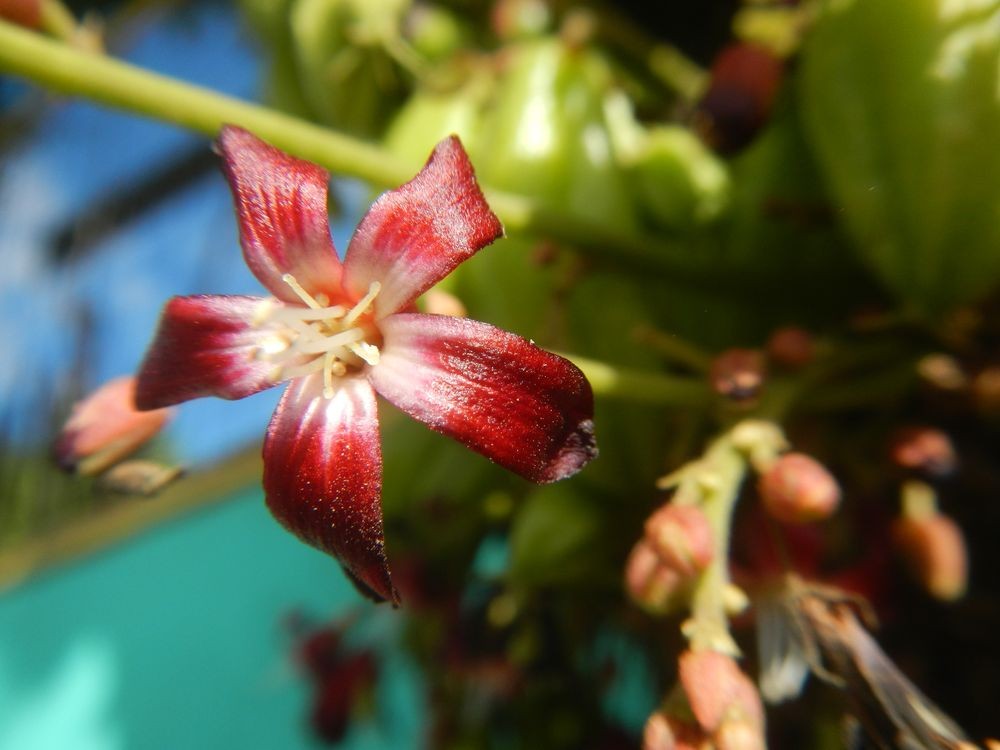
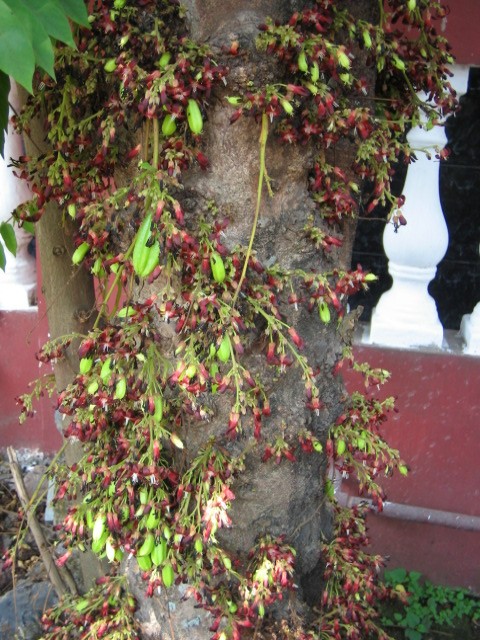
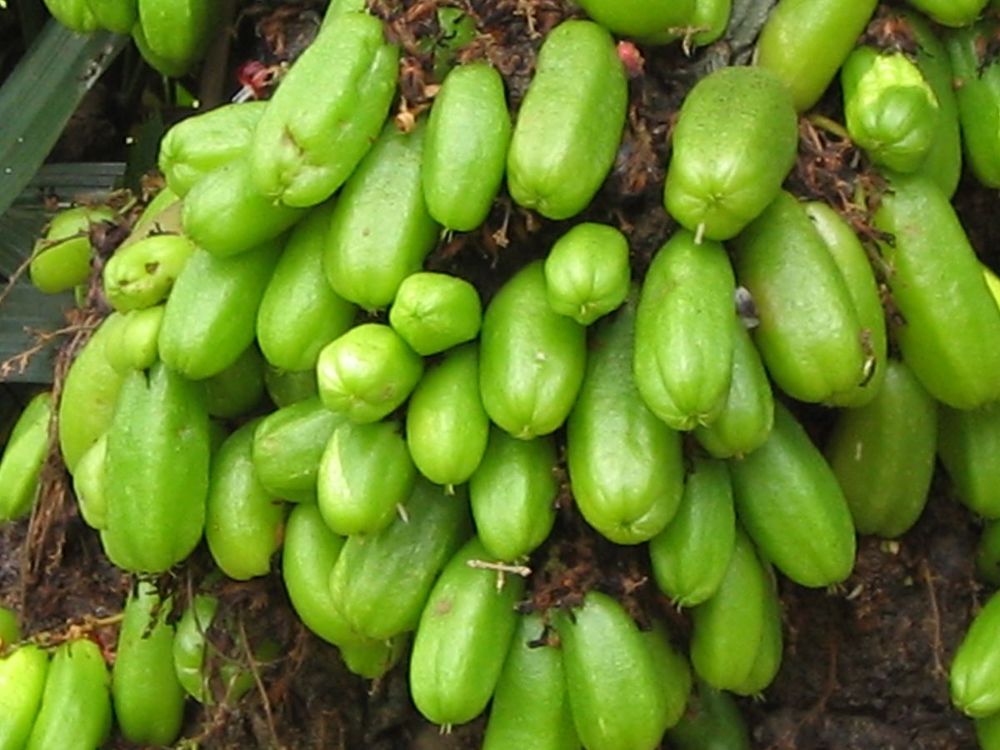
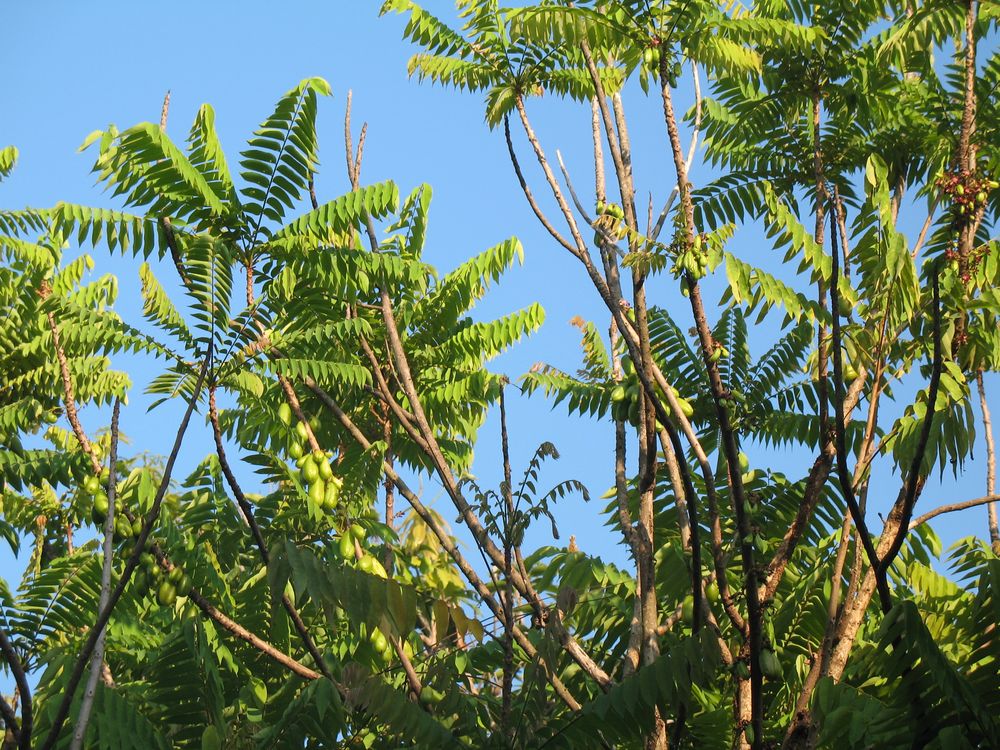
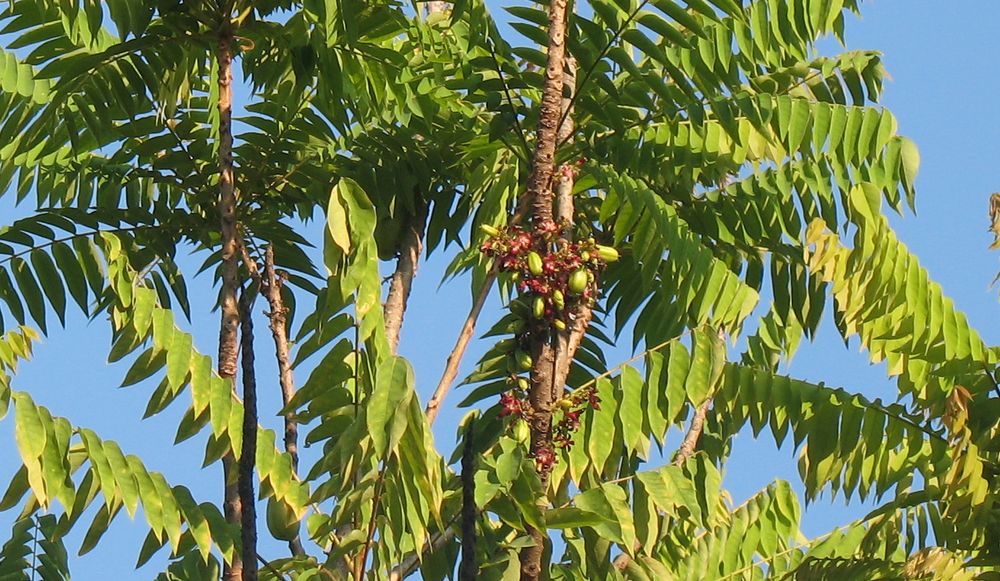
We know well in Laos the Carambolas which are very appreciated as acid fruits and which provide material for many preparations both savory and sweet. Much less is known of a very similar species, which has the same Lao name: mak feuang, and which, according to certain botanists, is even native to the Indochinese peninsula. It should however be noted that the scientific name of this small fruit, bilimbi, comes from a Malay language, which supposes a larger origin, the famous Indo-Malay zone.
The Cucumber Tree is distinguished from the Carambola by its leaves with much more numerous leaflets which give the foliage a lighter appearance. Moreover, the cauliflory is much more pronounced than for the Carambola and you can see the trunk and the branches of this tree entirely covered with flowers and then with fruits. The purple-brown flowers in small, slightly fragrant clusters arise from the trunk or twigs and follow one another without interruption throughout the year. The fruit has the size and shape of a gherkin with more or less marked 5 angles, with a smooth pale green skin then yellowish when ripening.
Bilimbi is much more acidic than starfruit and is rarely eaten raw. In general, the fruits are left to dry in the sun after having been cut in half and salted; they are then plunged into vinegar or brine where they can be kept for several months. They can then replace pickles or capers. They are deliciously acidic, added to curries or in chutneys in place of mangoes. The flowers themselves are sometimes candied in sugar. A juice is extracted from the fruits which complements other drinks, often for medicinal purposes. Indeed, Bilimbi are particularly rich in vitamin C. and oxalic acid; this acid was used in the past to remove blood or rust stains from linen.
In traditional Lao medicine, Bilimbi juice is recommended as a blood purifier and antiseptic; the sap applied to the skin is also said to be a good remedy for rashes.
Carambola and Bilimbi were once of great help in the fight against scurvy, this disease of sailors who go to sea for long months without fresh food, especially vitamin C.; we can also think that it is for this reason that Linnaeus named this genus Averrhoa, after one of the greatest thinkers of Muslim Spain, Averroes, who practiced medicine in Cordoba in the 12th century.
On connaît bien au Laos les caramboles qui sont très appréciées comme fruits acides et qui fournissent matière à nombre de préparations tant salées que sucrées. On connaît beaucoup moins une espèce très voisine, qui a le même nom lao: mak feuang, et qui selon certains botanistes seraient même originaire de la péninsule indochinoise. Il faut cependant noter que le nom scientifique de ce petit fruit, bilimbi, vient d’une langue malaise, ce qui suppose une origine plus vaste, la fameuse zone indo-malaise.
L’arbre à cornichons indien se distingue du carambolier par ses feuilles aux folioles beaucoup plus nombreuses qui donnent au feuillage un aspect plus léger. Par ailleurs, la cauliflorie est beaucoup plus prononcée que pour le carambolier et l’on peut voir le tronc et les rameaux de cet arbre entièrement couvert de fleurs puis de fruits. Les fleurs d’un brun pourpres en petites grappes légèrement parfumées surgissent du tronc ou des rameaux et se succèdent sans interruption pendant toute l’année. Le fruit a la taille et la forme d’un cornichon à 5 angles plus ou moins marqués, avec une peau lisse vert pâle puis jaunâtre en mûrissant.
Le bilimbi est beaucoup plus acide que la carambole et est rarement mangé cru. En général, on met les fruits à sécher au soleil après les avoir coupés en deux et salés; on les plonge ensuite dans du vinaigre ou dans une saumure où ils se conservent plusieurs mois. Ils peuvent alors remplacer les cornichons ou les câpres. Ils sont délicieusement acides, ajoutés aux cary ou dans les chutney à la place des mangues. Les fleurs elles-mêmes sont parfois confites dans le sucre. On extrait des fruits un jus qui vient en complément d’autres boissons, souvent dans un but médicinal. En effet, les bilimbi sont particulièrement riches en vitamine C. et en acide oxalique; cet acide permettait d’ailleurs, autrefois, d’enlever les taches de sang ou de rouille sur le linge.
En médecine traditionnelle lao, on recommande le jus de bilimbi comme purifiant le sang et antiseptique; le suc appliqué sur la peau passe aussi pour un bon remède contre les éruptions cutanées.
Carambole et bilimbi étaient autrefois d’un précieux secours pour lutter contre le scorbut, cette maladie des marins qui partent en mer de longs mois sans apport alimentaire frais, en particulier en vitamine C.; on peut d’ailleurs penser que c’est pour cette raison que Linné a nommé ce genre Averrhoa, du nom de l’un des plus grands penseurs de l’Espagne musulmane, Averroès, qui exerça la médecine à Cordoue au XIIème siècle.










We know well in Laos the Carambolas which are very appreciated as acid fruits and which provide material for many preparations both savory and sweet. Much less is known of a very similar species, which has the same Lao name: mak feuang, and which, according to certain botanists, is even native to the Indochinese peninsula. It should however be noted that the scientific name of this small fruit, bilimbi, comes from a Malay language, which supposes a larger origin, the famous Indo-Malay zone.
The Cucumber Tree is distinguished from the Carambola by its leaves with much more numerous leaflets which give the foliage a lighter appearance. Moreover, the cauliflory is much more pronounced than for the Carambola and you can see the trunk and the branches of this tree entirely covered with flowers and then with fruits. The purple-brown flowers in small, slightly fragrant clusters arise from the trunk or twigs and follow one another without interruption throughout the year. The fruit has the size and shape of a gherkin with more or less marked 5 angles, with a smooth pale green skin then yellowish when ripening.
Bilimbi is much more acidic than starfruit and is rarely eaten raw. In general, the fruits are left to dry in the sun after having been cut in half and salted; they are then plunged into vinegar or brine where they can be kept for several months. They can then replace pickles or capers. They are deliciously acidic, added to curries or in chutneys in place of mangoes. The flowers themselves are sometimes candied in sugar. A juice is extracted from the fruits which complements other drinks, often for medicinal purposes. Indeed, Bilimbi are particularly rich in vitamin C. and oxalic acid; this acid was used in the past to remove blood or rust stains from linen.
In traditional Lao medicine, Bilimbi juice is recommended as a blood purifier and antiseptic; the sap applied to the skin is also said to be a good remedy for rashes.
Carambola and Bilimbi were once of great help in the fight against scurvy, this disease of sailors who go to sea for long months without fresh food, especially vitamin C.; we can also think that it is for this reason that Linnaeus named this genus Averrhoa, after one of the greatest thinkers of Muslim Spain, Averroes, who practiced medicine in Cordoba in the 12th century.
On connaît bien au Laos les caramboles qui sont très appréciées comme fruits acides et qui fournissent matière à nombre de préparations tant salées que sucrées. On connaît beaucoup moins une espèce très voisine, qui a le même nom lao: mak feuang, et qui selon certains botanistes seraient même originaire de la péninsule indochinoise. Il faut cependant noter que le nom scientifique de ce petit fruit, bilimbi, vient d’une langue malaise, ce qui suppose une origine plus vaste, la fameuse zone indo-malaise.
L’arbre à cornichons indien se distingue du carambolier par ses feuilles aux folioles beaucoup plus nombreuses qui donnent au feuillage un aspect plus léger. Par ailleurs, la cauliflorie est beaucoup plus prononcée que pour le carambolier et l’on peut voir le tronc et les rameaux de cet arbre entièrement couvert de fleurs puis de fruits. Les fleurs d’un brun pourpres en petites grappes légèrement parfumées surgissent du tronc ou des rameaux et se succèdent sans interruption pendant toute l’année. Le fruit a la taille et la forme d’un cornichon à 5 angles plus ou moins marqués, avec une peau lisse vert pâle puis jaunâtre en mûrissant.
Le bilimbi est beaucoup plus acide que la carambole et est rarement mangé cru. En général, on met les fruits à sécher au soleil après les avoir coupés en deux et salés; on les plonge ensuite dans du vinaigre ou dans une saumure où ils se conservent plusieurs mois. Ils peuvent alors remplacer les cornichons ou les câpres. Ils sont délicieusement acides, ajoutés aux cary ou dans les chutney à la place des mangues. Les fleurs elles-mêmes sont parfois confites dans le sucre. On extrait des fruits un jus qui vient en complément d’autres boissons, souvent dans un but médicinal. En effet, les bilimbi sont particulièrement riches en vitamine C. et en acide oxalique; cet acide permettait d’ailleurs, autrefois, d’enlever les taches de sang ou de rouille sur le linge.
En médecine traditionnelle lao, on recommande le jus de bilimbi comme purifiant le sang et antiseptique; le suc appliqué sur la peau passe aussi pour un bon remède contre les éruptions cutanées.
Carambole et bilimbi étaient autrefois d’un précieux secours pour lutter contre le scorbut, cette maladie des marins qui partent en mer de longs mois sans apport alimentaire frais, en particulier en vitamine C.; on peut d’ailleurs penser que c’est pour cette raison que Linné a nommé ce genre Averrhoa, du nom de l’un des plus grands penseurs de l’Espagne musulmane, Averroès, qui exerça la médecine à Cordoue au XIIème siècle.


